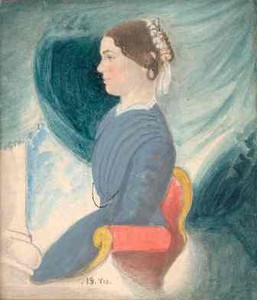Lyman & Merrie Wood Museum of Springfield History, Springfield History Theater, Second Floor
In the digital age it is hard to believe that at one time images of family members were hard to obtain, expensive, and relatively rare. Before the advent of photography around 1850, the only way to capture a likeness was to hire an artist to paint a portrait.
Portraits created during this period were almost always of rich or powerful people. In New England at that time, there were no art academies where people could hire trained artists so a number of folk artists emerged to meet the demand for portraits. These artists learned their skills on their own or from neighboring artists, and then traveled from town to town seeking customers who wanted portraits. James Sanford Ellsworth and Joseph Whiting Stock are two of the most important itinerant artists working in Western Massachusetts during this period.
James Sanford Ellsworth was born in Windsor, Connecticut, in 1802. A painter of silhouettes, portraits, and miniatures, he traveled throughout Western Massachusetts, Connecticut and New York in the 1840s and ’50s. Although he enjoyed a measure of success in his lifetime, a contemporary of his reported that he died “poor and friendless” in a poorhouse in Pittsburgh, Pennsylvania, in 1874. The Springfield Museums owns the largest public collection of Ellsworth miniatures.
Joseph Whiting Stock was born in Springfield in 1815. When he was eleven years old, he suffered a crippling injury when an ox cart fell and crushed his legs. After a lengthy recuperation, his doctor encouraged him to study art. Unable to walk, Stock was limited at first to a few clients in Springfield until a doctor designed a flexible wheelchair that allowed him to travel with greater ease. Over the course of his career he traveled to Wilbraham, Stafford, New Haven, New Bedford, Rhode Island and New York. His work included miniatures and portraits of deceased children. Stock died of tuberculosis 1855.

